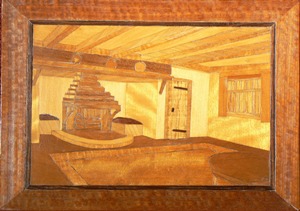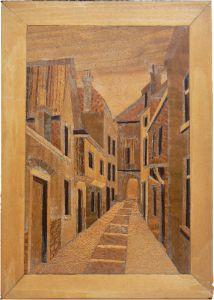
|
BENCH ENDS AND GREEN MEN IN SUFFOLK AND NORFOLK CHURCHES
WHY? WELL, WHY NOT? OK THEN... INTRODUCTION
In recent years my love of wood has led to an interest in bench ends, and misericords as well, because of the fascinating carvings to be found on many of them. That word misericord by the way - my dictionary gives the derivation as being from the Latin misericordia, meaning tenderhearted, but I also noted that another (English) meaning is a narrow-bladed dagger for killing a wounded foe. Yes, well... However, the origin of this church furnishing is itself interesting. In cathedrals and abbeys the choir stalls had seats, but the long daily offices had to be sung by the monks standing up. Only at parts of the Mass and Vespers were they able to sit. Eventually this rule was relaxed and misericords were introduced - a cunning ledge fitted on the underside of the seat against which the monks could perch while still appearing to be upright. These eventually gave great opportunity to the craftsmen to show their skills, and some splendid carvings of figures resulted - not always of the most reverent nature although as they were underneath the ledge they were not in the general view of the congregation. In Britain the earliest misericords still to be seen date from the 13th century. But the ones with the intriguing carvings need searching out with much prowling in chancels tipping up seats to see what is below. As far as parish churches go, until about the 14th century, according to James Collet-White (see below), there was no seating in the nave and congregations stood throughout the services, although some churches had stone ledges along the walls of the nave to which the weary or elderly ones could have resource. I have seen it suggested that this is the origin of the saying "The weakest go to the wall". When benches were introduced they were at first unadorned, in fact the very early ones were backless, but then the craftsmen saw their golden opportunity and intricate carvings were introduced on the bench ends. In East Anglia particularly the top of the panel bore a poppyhead in the shape of a fleur de lys. "Poppyhead" apparently comes from the French poupée, meaning puppet or figurehead. Then, with more experience and obvious exuberance, such figures as saints, mythological creatures and the Seven Deadly Sins were carved on the arm rests and these provide a veritable feast of viewing. In that delightful book Suffolk Churches, a Pocket Guide, published by the Suffolk Historic Churches Trust in 1977, James Collett-White describes numerous examples in churches across the county. He said that the best sets of these carved bench ends are those at Dennington, Fressingfield, Lakenheath, Stowlangcroft and Tostock. We shall see, for I have begun to explore local churches seeking them out for myself and it is to him that I am indebted for a starting list on what to see where. If my prowlings discover some good misericords they will also appear on these pages. In some of my photos of bench ends mutilation of the figures to a greater or lesser extent is apparent. It is often said that this destruction or defacement of paintings and images in churches was carried out on the order of Oliver Cromwell. But in fact it was another Cromwell - Thomas, a minister to Henry VIII - who encouraged the start of a much greater iconoclasm which carried on into and throughout the next two reigns, varying in intensity, so that by the end of the 16th century much destruction of religious images had been carried out. Early in the 1600's a slightly more tolerant attitude began to creep in, but this in turn resulted in a reaction by die-hard Puritan iconoclasts. Various Government ordinances restarted the intensive destruction and one in particular - in August 1643 - commanded the removal of religious images from churches in the Eastern Counties. At the same time, during the Civil War, churches were often used as fall-back defensive positions or even as excellent places from which to attack the opposing side - their towers being ideal both as look-outs and for shooting down on the enemy. Much damage to the churches obviously resulted from this. Of those deputed to carry out the renewed iconoclasm probably the best known is William Dowsing because he kept a journal of his work. Born in Laxfield, Suffolk, he was responsible for that county and also Cambridgeshire. A new edition of The Journal of William Dowsing, by Trevor Cooper, was published in 2001 and can be seen at his website (see link at the left). Where they are of interest I shall include the entry for each church we visit.
Green Men? Everything has to be green in these days of "Save the Planet", but these go back through the ages. There are disputes as to whether they originated in pagan times, whether they are interpretations of a certain deity of the old religions, or just decorative features. Whatever the truth, there are some interesting ones to be found in East Anglian churches which will feature here, be they of wood or stone, as I discover them in my wanderings.
Enough of the lecture, have a look at the pics. But first - one more of Dad's.
 ~~~~~~~~~~~~~~~
Sparse at the moment, but will grow with my wanderings.
|


 It may have been my father who aroused my interest in wood when he took up marquetry. The picture at the left, one of his, is of one of the Rows at Great Yarmouth, Norfolk, the old narrow lanes leading off the Market Place. That he had the patience, accuracy and above all enthusiasm to produce his pictures is all the more remarkable in that an injury when he was a boy meant the removal of one eye. Long ago, enthused by what he was doing and appreciative of the variety of colours and graining, I bought a box of small sample
It may have been my father who aroused my interest in wood when he took up marquetry. The picture at the left, one of his, is of one of the Rows at Great Yarmouth, Norfolk, the old narrow lanes leading off the Market Place. That he had the patience, accuracy and above all enthusiasm to produce his pictures is all the more remarkable in that an injury when he was a boy meant the removal of one eye. Long ago, enthused by what he was doing and appreciative of the variety of colours and graining, I bought a box of small sample